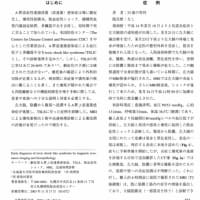Alert Cell Strategy in Severe Sepsis and Septic Shock PART3
Prof. Naoyuki Matsuda M.D., Ph.D.
Department of Emergency & Critical Care Medicine
Nagoya University Graduate School of Medicine, Nagoya, Japan
E-mail: nmatsuda@med.nagoya-u.ac.jp
5. AP-1 activation and apoptosis
AP-1 is activated in alert cells under severe conditions associated with SIRS, such as sepsis. While AP-1 functions in cell proliferation and differentiation 42), it also induces excessive synthesis of catecholamines in the central nervous system and apoptosis of alert cells in the periphery.
AP-1 genes consist of 4 families: Jun, Fos, activating transcription factor (ATF), and the musculoaponeurotic fibrosarcoma (MAF) oncogene. Jun homodimers or Jun/Fos heterodimers recognize and bind to the phorbol 12-O-tetradecanoylphorbol-13-acetate-responsive element (TPA-responsive element; TRE), and Jun/ATF complexes bind to CRE, leading to the transcriptional induction of inflammatory markers (COX-2, ICAM-1), matrix metalloproteinases (MMP-1, MMP-3, MMP-9), and proteins involved in actin polymerization (CapG, Ezrin, Krp-1, Mts-1) 43).
MAPK is a serine/threonine kinase comprised of 4 subfamilies: extracellular signal-regulated kinase (ERK), Jun-N-terminal protein kinase (JNK), p38 MAPK, and ERK5/big MAPK1 (BMK1). In sepsis, MAPK is activated in response to TAK-1 activation in alert cells. This leads to the subsequent transcriptional activation of AP-1 targets. JNK is activated during sepsis and phosphorylates the N-terminal transcriptional activation domains (TADs) of Jun family members, such as c-Jun, JunB, and JunD. ERK phosphorylates the TADs of Fos family members, such as c-Fos, FosB, Fra-1, and Fra-2. These phosphorylation events induce the heterodimerization of Jun and Fos family members or stabilize Jun homodimers, resulting in increased binding to the AP-1 binding site TRE (TGACTCA). While c-Jun, c-Fos, and FosB have N-terminal TADs, the TADs of JunB, JunD, Fra-1, Fra-2, and FosB2 are weak. As such, they are weak AP-1 transcriptional activators 43). With respect to ATF family members (e.g., ATF-2, ATF-3, B-ATF), phosphorylation by JNK or p38MAPK leads to their homodimerization or heterodimerization with Jun family members and increased binding to CRE sites (TGACGTCA) 44). AP-1 activation tends to be delayed compared to NF-κB activation 8). One likely reason for this is that the temporary activation of phosphatases that inhibit MAPK (e.g., protein phosphatase 2A, protein phosphatase 2C, and MAPK phosphatase) is carried out by MAPK itself.
JNK, ERK1/2, and p38MAPK phosphorylation increases 24 hours after the CLP procedure in male BALB-C mice. Gel shift analysis reveals that lung AP-1 activity increases to more than 15-fold of basal activity in. in CLP mice. This increase can be inhibited by administering CLP mice double stranded decoy oligonucleotides containing TRE and CRE elements , or a TRE element alone. Furthermore, inhibiting AP-1 activity in this way can reduce apoptosis in septic lungs (type II alveolar epithelial cells are the main cells undergoing apoptosis in this context) (Figure 6), leading to a significant improvement in the survival rate of septic mice. Moreover, TNF-R1, Fas, DR4, DR5, and FADD transcripts increase in the lungs of CLP mice by AP-1 activation (Figure 7). In the lungs, type II alveolar epithelial cells differentiate into type I alveolar epithelial cells on the alveolar basement membrane. Protecting these cells is important, as it attenuates acute pulmonary disorder that complicates sepsis 40). Given the above, AP-1 can be considered an exacerbating factor in sepsis that contributes to increased death signaling in alert cells.
6. Kruppel-Like Transcriptional Factor (KLF)
KLF is a transcription factor of the zinc finger family that has recently gained attention for its role in reducing inflammation in vascular endothelial cells and inducing endothelial NO synthetase (eNOS) and thrombomodulin expression in these cells. KLF exhibits anti-inflammatory effects and inhibits signaling through the thrombin receptor PAR1 in vascular endothelial cells 45). Its role in inhibiting AP-1 and NF-κB activity in vascular endothelial cells has also been reported 46-48).
In early stages of sepsis, iNOS expression increases in blood vessels, while eNOS expression decreases22, 49). Distributive shock results when blood vessels subsequently become dilated and exhibit impaired blood flow regulation due to shear stress. A potential mechanism that underlies the simultaneous increase in iNOS and decrease in eNOS involves the nuclear translocation of NF-κB 50). In this mechanism, nuclear NF-κB mediates the over-production of iNOS mRNA, as well as histone acetylation, which consequently leads to a decrease in KLF2 and KLF4 transcripts and eNOS expression. Statins can recover decreased eNOS levels in sepsis 22), and this may be related to the ability of statins to increase KLF expression in vascular endothelial cells 45 46). Given that statins are considered to improve prognosis, they may have potential applications in the clinical setting for sepsis management.
Conclusion
Rather than pursuing individual molecules in septic therapy, this paper approached the topic of multiple organ dysfunction that complicates sepsis from the viewpoint of mRNA production, with focus placed on the transcription factors NF-κB and AP-1. Inflammation is exacerbated by the increase in number of alert cells associated with sepsis progression. Major organs become impaired in function as apoptosis increases in sepsis. The theory of rescuing these alert cells from inflammation and apoptosis during and following inflammation is called the “alert cell strategy.” DR signaling and apoptosis are likely to become crucial targets of therapy in prolonged sepsis management.
2010 Matsuda's Inflammation laboratory









to be continued
Prof. Naoyuki Matsuda M.D., Ph.D.
Department of Emergency & Critical Care Medicine
Nagoya University Graduate School of Medicine, Nagoya, Japan
E-mail: nmatsuda@med.nagoya-u.ac.jp
5. AP-1 activation and apoptosis
AP-1 is activated in alert cells under severe conditions associated with SIRS, such as sepsis. While AP-1 functions in cell proliferation and differentiation 42), it also induces excessive synthesis of catecholamines in the central nervous system and apoptosis of alert cells in the periphery.
AP-1 genes consist of 4 families: Jun, Fos, activating transcription factor (ATF), and the musculoaponeurotic fibrosarcoma (MAF) oncogene. Jun homodimers or Jun/Fos heterodimers recognize and bind to the phorbol 12-O-tetradecanoylphorbol-13-acetate-responsive element (TPA-responsive element; TRE), and Jun/ATF complexes bind to CRE, leading to the transcriptional induction of inflammatory markers (COX-2, ICAM-1), matrix metalloproteinases (MMP-1, MMP-3, MMP-9), and proteins involved in actin polymerization (CapG, Ezrin, Krp-1, Mts-1) 43).
MAPK is a serine/threonine kinase comprised of 4 subfamilies: extracellular signal-regulated kinase (ERK), Jun-N-terminal protein kinase (JNK), p38 MAPK, and ERK5/big MAPK1 (BMK1). In sepsis, MAPK is activated in response to TAK-1 activation in alert cells. This leads to the subsequent transcriptional activation of AP-1 targets. JNK is activated during sepsis and phosphorylates the N-terminal transcriptional activation domains (TADs) of Jun family members, such as c-Jun, JunB, and JunD. ERK phosphorylates the TADs of Fos family members, such as c-Fos, FosB, Fra-1, and Fra-2. These phosphorylation events induce the heterodimerization of Jun and Fos family members or stabilize Jun homodimers, resulting in increased binding to the AP-1 binding site TRE (TGACTCA). While c-Jun, c-Fos, and FosB have N-terminal TADs, the TADs of JunB, JunD, Fra-1, Fra-2, and FosB2 are weak. As such, they are weak AP-1 transcriptional activators 43). With respect to ATF family members (e.g., ATF-2, ATF-3, B-ATF), phosphorylation by JNK or p38MAPK leads to their homodimerization or heterodimerization with Jun family members and increased binding to CRE sites (TGACGTCA) 44). AP-1 activation tends to be delayed compared to NF-κB activation 8). One likely reason for this is that the temporary activation of phosphatases that inhibit MAPK (e.g., protein phosphatase 2A, protein phosphatase 2C, and MAPK phosphatase) is carried out by MAPK itself.
JNK, ERK1/2, and p38MAPK phosphorylation increases 24 hours after the CLP procedure in male BALB-C mice. Gel shift analysis reveals that lung AP-1 activity increases to more than 15-fold of basal activity in. in CLP mice. This increase can be inhibited by administering CLP mice double stranded decoy oligonucleotides containing TRE and CRE elements , or a TRE element alone. Furthermore, inhibiting AP-1 activity in this way can reduce apoptosis in septic lungs (type II alveolar epithelial cells are the main cells undergoing apoptosis in this context) (Figure 6), leading to a significant improvement in the survival rate of septic mice. Moreover, TNF-R1, Fas, DR4, DR5, and FADD transcripts increase in the lungs of CLP mice by AP-1 activation (Figure 7). In the lungs, type II alveolar epithelial cells differentiate into type I alveolar epithelial cells on the alveolar basement membrane. Protecting these cells is important, as it attenuates acute pulmonary disorder that complicates sepsis 40). Given the above, AP-1 can be considered an exacerbating factor in sepsis that contributes to increased death signaling in alert cells.
6. Kruppel-Like Transcriptional Factor (KLF)
KLF is a transcription factor of the zinc finger family that has recently gained attention for its role in reducing inflammation in vascular endothelial cells and inducing endothelial NO synthetase (eNOS) and thrombomodulin expression in these cells. KLF exhibits anti-inflammatory effects and inhibits signaling through the thrombin receptor PAR1 in vascular endothelial cells 45). Its role in inhibiting AP-1 and NF-κB activity in vascular endothelial cells has also been reported 46-48).
In early stages of sepsis, iNOS expression increases in blood vessels, while eNOS expression decreases22, 49). Distributive shock results when blood vessels subsequently become dilated and exhibit impaired blood flow regulation due to shear stress. A potential mechanism that underlies the simultaneous increase in iNOS and decrease in eNOS involves the nuclear translocation of NF-κB 50). In this mechanism, nuclear NF-κB mediates the over-production of iNOS mRNA, as well as histone acetylation, which consequently leads to a decrease in KLF2 and KLF4 transcripts and eNOS expression. Statins can recover decreased eNOS levels in sepsis 22), and this may be related to the ability of statins to increase KLF expression in vascular endothelial cells 45 46). Given that statins are considered to improve prognosis, they may have potential applications in the clinical setting for sepsis management.
Conclusion
Rather than pursuing individual molecules in septic therapy, this paper approached the topic of multiple organ dysfunction that complicates sepsis from the viewpoint of mRNA production, with focus placed on the transcription factors NF-κB and AP-1. Inflammation is exacerbated by the increase in number of alert cells associated with sepsis progression. Major organs become impaired in function as apoptosis increases in sepsis. The theory of rescuing these alert cells from inflammation and apoptosis during and following inflammation is called the “alert cell strategy.” DR signaling and apoptosis are likely to become crucial targets of therapy in prolonged sepsis management.
2010 Matsuda's Inflammation laboratory









to be continued



























